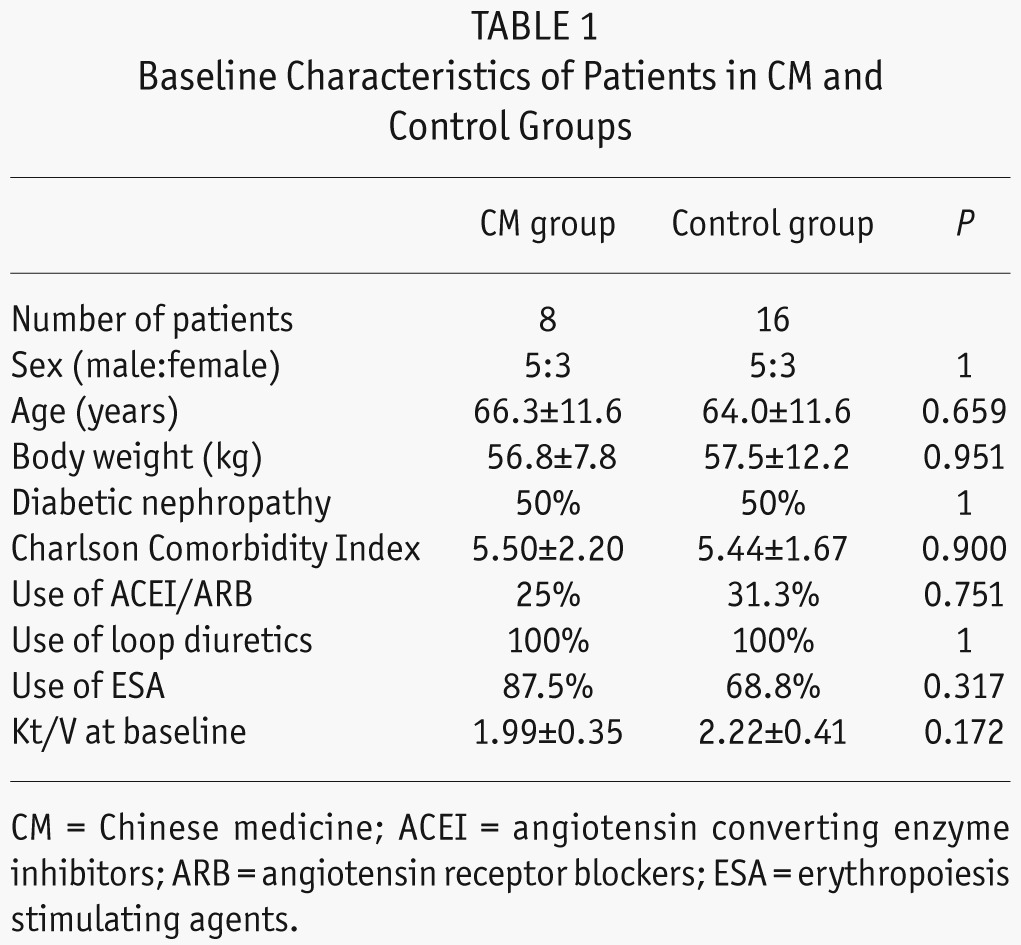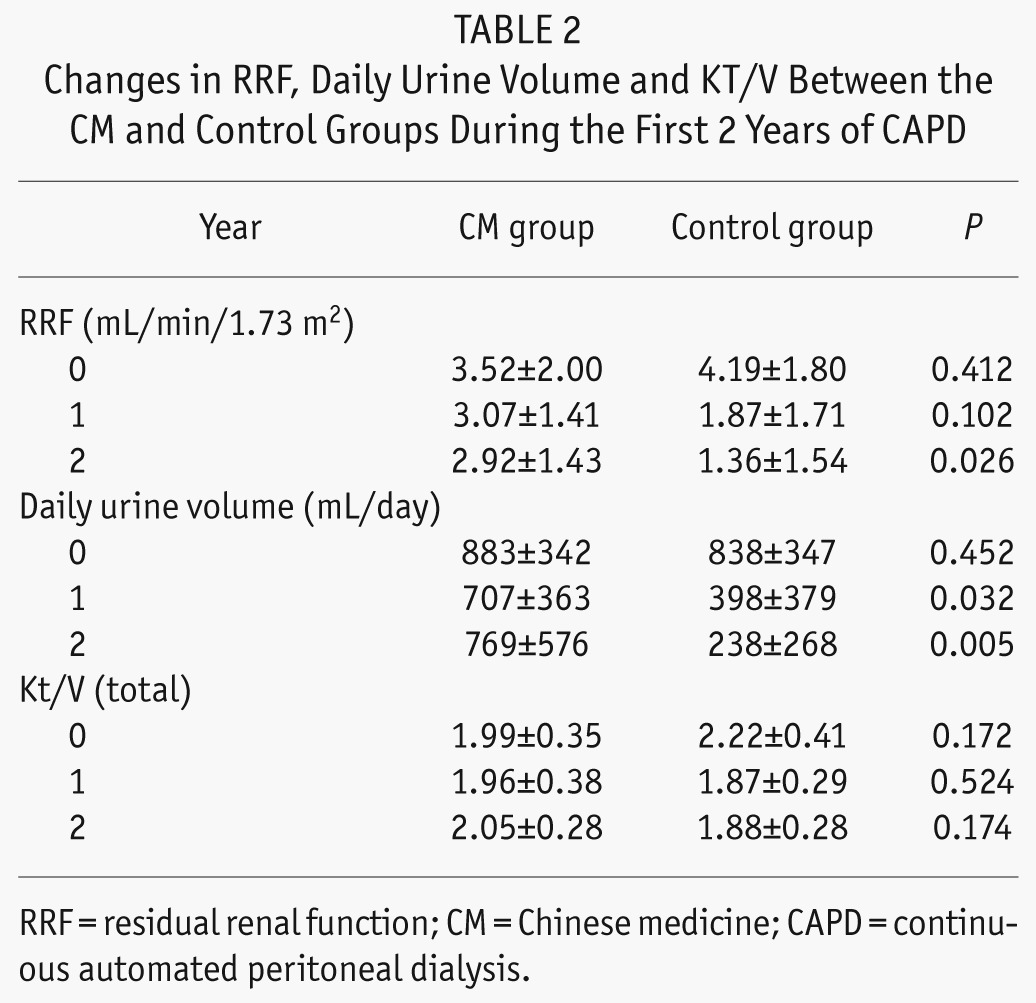Preservation of residual renal function (RRF) has important survival benefits for patients undergoing continuous ambulatory peritoneal dialysis (CAPD) (1). Effective measures that can slow down the loss of RRF in CAPD patients are still limited and there is a need to identify new therapeutic options. Traditional Chinese medicine is frequently used in conjunction with Western medicine among patients with chronic kidney diseases in China and many Asian countries (2).
Astragalus membranaceus is a traditional Chinese herbal medicine with potent anti-fibrotic properties and is commonly used for strengthening the immune system, improving cardiovascular function, and enhancing vitality (3). Some of our patients have been treated with Astragalus membranaceus-based Chinese medicine formulae since the commencement of CAPD, primarily to improve their general wellbeing and vitality. The aim of this study was to determine the effects of Astragalus membranaceus-based Chinese medicine formulae on RRF and daily urine volume in patients on CAPD.
Subjects and Methods
This study is a retrospective, single-center, case control, observational study. The study protocol was approved by the Hospital's Institutional Review Board. Patients more than 18 years of age with RRF more than 1 mL/min/1.73 m2, who had received Astragalus membranaceus-based Chinese medicine formulae since the commencement of CAPD and continued for at least 2 years (CM group) were identified from hospital chart review. Control patients consisted of stable CAPD patients selected from among 180 peritoneal dialysis (PD) patients in our center who had not received Chinese medicine, matched for age, sex, duration of dialysis and diabetic status with the patients in the CM group in a 2:1 ratio (control group).
The Astragalus membranaceus-based Chinese medicine formulae contained Astragalus membranaceus and a number of other herbs (such as Epimedium brevicornum Maxim, Salvia miltiorrhiza Bunge, Cuscuta chinensis Lam., Lycium barbarum L.). They were prescribed by a registered Chinese Medicine practitioner who managed the patients jointly with the nephrologist in our Integrated Medicine Clinic. The Astragalus membranaceus-based Chinese medicine formulae were ingested as decoction prepared from raw herbs in 5 patients and as concentrated Chinese medicine granules in 3 patients.
Residual renal function was measured from a 24-h urine sample and calculated as the mean of creatinine clearance and urea clearance, normalized to the standard body surface area of 1.73 m2. Residual renal function and daily urine volume were determined at the commencement of CAPD and then yearly thereafter. Statistical analysis was performed using SPSS (SPSS Inc., version 16, Chicago, IL, USA) statistical software. Numerical data are given as mean ± standard deviation (SD). Means between groups were compared with Student's t-test and Mann-Whitney test when appropriate. A p value equal to or less than 0.05 is considered statistically significant.
Results
Eight CM group and 16 control group patients were included in this analysis. The baseline demographic and clinical characteristics of the 2 groups of patients were similar (Table 1). The 2 groups also did not differ in their use of diuretics, angiotensin converting enzyme inhibitor (ACEI)/angiotensin receptor blocker (ARB) and erythropoiesis-stimulating agents. The mean dose of ACEI/ARB and loop diuretics given to the patients in the CM and control groups were similar. One patient in the CM group and 2 patients in the control group required a period of temporary hemodialysis prior to initiation of PD. Table 2 shows the changes in the RRF and daily urine volume of the CM and control groups in the first 2 years of CAPD. The RRF and daily urine volume of the CM and control groups were similar at baseline. Patients in the CM group had significantly higher RRF at 2 years and daily urine volume at 1 and 2 years. Their rate of decline of RRF and daily urine volume were significantly lower than those of the control group (-0.30 ± 0.40 mL/min/1.73 m2/year vs −1.42 ± 0.30 mL/min/1.73 m2/year, p = 0.004 and −56.9 ± 108.5 mL/day/year vs −299.8 ± 59.7 mL/day/year, p = 0.007, respectively). Kt/V values of the 2 groups were similar at all time-points. The proportion of patients who were peritonitis-free at 2 years did not differ between the 2 groups (87.5% vs 81.3%, p = 0.699).
TABLE 1.
Baseline Characteristics of Patients in CM and Control Groups

TABLE 2.
Changes in RRF, Daily Urine Volume and KT/V Between the CM and Control Groups During the First 2 Years of CAPD

Discussion
The therapeutic options of proven value in preserving RRF in CAPD patients are limited. The potential benefits of biocompatible dialysis fluids remain controversial (4). Expansion of extracellular volume in PD patients was not helpful in retarding the loss of RRF (5). The findings of this study highlight the potential of Chinese herbal medicine in preserving RRF in CAPD patients. The CM and control group patients have similar baseline demographic and clinical characteristics. Their usage of diuretics and ACEI/ARB, adequacy of dialysis, and peritonitis-free rate also did not differ, suggesting that the better preservation of RRF in the CM group could be related to the consumption of Chinese herbal medicine.
The exact mechanisms by which Astragalus membranaceus-based Chinese medicine formulae help to preserve RRF in CAPD patients are not completely understood. In animal studies, it has been demonstrated that treatment with Astragalus membranaceus is effective in reducing renal interstitial fibrosis in diabetic nephropathy (6) and progressive proteinuric nephropathy (7). The renal protective effects of Astragalus membranaceus is believed to be mediated, in part, through suppression of transforming growth factor beta expression (8) and enhancement of nitric oxide production (9).
The Astragalus membranaceus-based Chinese medicine formulae were prescribed to our patients initially to enhance their general wellbeing and vitality. The observed effects of the Chinese medicine formulae on RRF appear to be an added advantage. It is also worth noting the Astragalus membranaceus-based Chinese medicine formulae contain a number of other herbs which serve to assist or augment the therapeutic effects of Astragalus membranaceus, in accordance with the principles of Chinese herbal formulation (10).
This study is retrospective in nature and involved a relatively small number of patients. Given the association between RRF and survival, it is possible that our observations are contaminated by survivor bias. Nevertheless, our findings suggest that the use of Astragalus membranaceus-based Chinese medicine formulae might be beneficial in preserving RRF in CAPD patients during the first 2 years of dialysis. Further prospective randomized control trials are warranted to confirm these preliminary observations.
Disclosures
The authors have no financial conflicts of interest to declare.
Acknowledgments
This study was supported by the Tung Wah Group of Hospitals Research Fund.
REFERENCES
- 1. Perl J, Bargman JM. The importance of residual kidney function for patients on dialysis: a critical review. Am J Kidney Dis 2009; 53:1068–81. [DOI] [PubMed] [Google Scholar]
- 2. Zhong Y, Deng Y, Chen Y, Chuang PY, Cijiang He J. Therapeutic use of traditional Chinese herbal medications for chronic kidney diseases. Kidney Int 2013; 84:1108–18. [DOI] [PMC free article] [PubMed] [Google Scholar]
- 3. Ren S, Zhang H, Mu Y, Sun M, Liu P. Pharmacological effects of Astragaloside IV: a literature review. J Tradit Chin Med 2013; 33:413–6. [DOI] [PubMed] [Google Scholar]
- 4. Blake PG, Jain AK, Yohanna S. Biocompatible peritoneal dialysis solutions: many questions but few answers. Kidney Int 2013; 84:864–6. [DOI] [PubMed] [Google Scholar]
- 5. McCafferty K, Fan S, Davenport A. Extracellular volume expansion, measured by multifrequency bioimpedance, does not help preserve residual renal function in peritoneal dialysis patients. Kidney Int 2014; 85:151–7. [DOI] [PubMed] [Google Scholar]
- 6. Zhang J, Xie X, Li C, Fu P. Systemic review of the renal protective effect of Astragalus membranaceus (root) on diabetic nephropathy in animal models. J Ethnopharmacol 2009; 126:189–96. [DOI] [PubMed] [Google Scholar]
- 7. Wang H, Li J, Yu L, Zhao Y, Ding W. Antifibrotic effect of the Chinese herbs, Astragalus mongholicus and Angelica sinensis, in a rat model of chronic puromycin aminonucleoside nephrosis. Life Sci 2004; 74:1645–58. [DOI] [PubMed] [Google Scholar]
- 8. Zhang YW, Xie D, Xia B, Zhen RT, Liu IM, Cheng JT. Suppression of transforming growth-factor-beta 1 gene expression by Danggui buxue tang, a traditional Chinese herbal preparation, in retarding the progress of renal damage in streptozotocin-induced diabetic rats. Horm Metab Res 2006; 38:82–8. [DOI] [PubMed] [Google Scholar]
- 9. Meng L, Qu L, Tang J, Cai SQ, Wang H, Li X. A combination of Chinese herbs, Astragalus membranaceus var. mongholicus and Angelica sinensis, enhanced nitric oxide production in obstructed rat kidney. Vascul Pharmacol 2007; 47:174–83. [DOI] [PubMed] [Google Scholar]
- 10. Xu B. Chinese herbal medicine and formulations. In: Yan CS, Bieber EJ, Bauer BA, eds. Traditional Chinese Medicine. London: Informa healthcare; 2011: 113–24. [Google Scholar]


